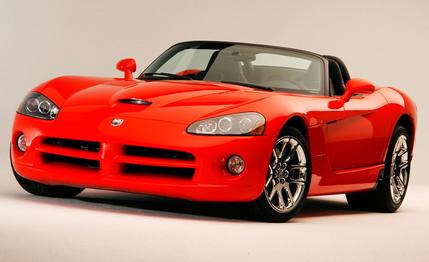 First Drive Review
First Drive Review

At the sight of a red prototype 2003 Dodge Viper SRT-10 wheeled out for a first drive, our little group of writers felt a rising sense of excitement. It was a frisson that even Dodge engineer Herb Helbig's aggressive admonition about abuse to his expensive plaything failed to subdue.
Just how something really catastrophic might occur on the vast expanse of black pavement at DaimlerChrysler's desert proving ground in Wittmann, Arizona, was not immediately evident, so most of us assumed that Helbig had simply become overly glandular at his car's first public trial.
One could hardly blame him for this unsettling display of territorialism. There on the asphalt stood millions of dollars' worth of prototype SRT-10—still only part way through its development process—and nobody but Helbig and his fellow engineers had ever set butt in it.

Seen away from the clutter of car-show surroundings for the first time, the more delicate image of the new Viper appeared clearly defined. Penned by design manager Osamu Shikado, a former Toyota designer responsible for Corolla and Camry exteriors, the new car has lost much of the brutal visual presence of the old roadster, gaining instead a well-integrated mix of elegance and purpose.
The wheelbase has been stretched by 2.6 inches, yet the car is actually slightly shorter overall than its predecessor, and it has relatively short overhangs fore and aft that greatly reduce the almost comically massive volumes of the early car. Shikado's first sketches incorporated rear exhaust outlets, but Viper team personnel prevailed in the end in keeping side exhausts—partly for tradition, mainly to be able to fit an undertail diffuser. That underbody wing will prove an invaluable aerodynamic aid for high-speed street stability as well as for future track work.
Intended from the outset to be a convertible, the new SRT-10 has lost the previous car's sport bar—getting twin hoops behind the occupants' heads in return—but it benefits greatly from its clean-sheet interior design. The doors and the side windows seem a perfect match for the classic dashboard sculpture. That simple-yet-modern dash, with its white dial faces and vertical line of secondary gauges, is an effective new motif for the Viper.
The biggest departure is the folding-clamshell top, which stacks away into a small recess behind the cabin. Fastened to the windshield surround with just a single latch, the top brings a much greater degree of versatility to the car, almost making a coupe version (which will surely follow) superfluous.
Under the svelte new skin we find the usual Viper characteristics, only they're more pronounced. Following a development catch-line of 500/500/500, the Viper's new V-10 has more than 500 cubic inches of displacement (8.3 liters) to achieve the 500 horsepower and 500 pound-feet of torque targets sought by Helbig and his power-hungry associates.
Although the engine still flaunts 10 cylinders in a 90-degree vee, with pushrod-actuated overhead valves (just two per pot, thanks), it is an all-new unit. Boasting bore and stroke dimensions just slightly oversquare at 4.03 and 3.96 inches, the engine's redline has risen 100 rpm, to 6100 rpm, with maximum power achieved 500 rpm below that. Although maximum twist occurs at 4600 rpm, we expect the same generous plateau of rubber-wringing torque to extend across the rev range.
A Tremec T-56 six-speed manual gearbox handles the prodigious output, using identical ratios to those found in previous Vipers. The final-drive ratio, too, is unchanged at 3.07:1, so the only thing that may affect the new car's gearing slightly is a switch from 18-inch rear-wheel rims wearing 335/30ZR-18 Michelins to 19-inch units shod with 345s.
Giant Brembo cast-iron discs assume responsibility for slowing the Viper, abetted by a more fully developed version of the anti-lock brake system introduced in 2001.